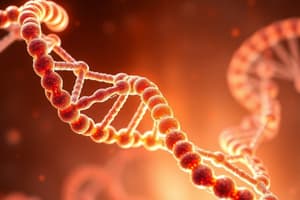Podcast
Questions and Answers
What prevents tangling and supercoiling during DNA replication?
What prevents tangling and supercoiling during DNA replication?
- Topoisomerases (correct)
- Single-strand binding proteins
- DNA polymerase
- RNA primer
In which direction does DNA synthesis always proceed?
In which direction does DNA synthesis always proceed?
- Both 3' → 5' and 5' → 3'
- 5' → 3' (correct)
- Depends on the strand type
- 3' → 5'
Which strand is synthesized continuously toward the replication fork?
Which strand is synthesized continuously toward the replication fork?
- Lagging strand
- Okazaki fragments
- RNA primer strand
- Leading strand (correct)
What is the role of DNA ligase in DNA replication?
What is the role of DNA ligase in DNA replication?
How do prokaryotic DNA replication and eukaryotic DNA replication differ?
How do prokaryotic DNA replication and eukaryotic DNA replication differ?
What is synthesized by DNA primase during replication?
What is synthesized by DNA primase during replication?
What structure is formed where the replication occurs?
What structure is formed where the replication occurs?
What components make up a nucleotide in DNA?
What components make up a nucleotide in DNA?
What are short fragments on the lagging strand known as?
What are short fragments on the lagging strand known as?
Which of the following correctly describes the structure of DNA?
Which of the following correctly describes the structure of DNA?
Which process occurs in eukaryotic cells during interphase?
Which process occurs in eukaryotic cells during interphase?
What is the distance between adjacent base pairs in the DNA double helix?
What is the distance between adjacent base pairs in the DNA double helix?
Which protein binds to single-stranded DNA during replication to stabilize it?
Which protein binds to single-stranded DNA during replication to stabilize it?
Which statement about DNA replication is true?
Which statement about DNA replication is true?
What type of bonding holds the two chains of the DNA helix together?
What type of bonding holds the two chains of the DNA helix together?
According to Chargaff's rules, which base pairs are complementary?
According to Chargaff's rules, which base pairs are complementary?
Which model of DNA replication describes a scenario where parental and newly synthesized strands are mixed?
Which model of DNA replication describes a scenario where parental and newly synthesized strands are mixed?
What characteristic of DNA's polynucleotide chains allows for complementary base pairing?
What characteristic of DNA's polynucleotide chains allows for complementary base pairing?
How does the structure of DNA contribute to its function as a carrier of genetic information?
How does the structure of DNA contribute to its function as a carrier of genetic information?
What is the outcome after transferring E. coli from 15N to 14N medium for one generation?
What is the outcome after transferring E. coli from 15N to 14N medium for one generation?
Which process describes semiconservative replication?
Which process describes semiconservative replication?
What role do DNA helicases play in DNA replication?
What role do DNA helicases play in DNA replication?
Which statement accurately describes the components of hybrid DNA?
Which statement accurately describes the components of hybrid DNA?
How do single-strand binding (SSB) proteins contribute to DNA replication?
How do single-strand binding (SSB) proteins contribute to DNA replication?
What enables the determination of DNA molecule locations within a centrifuge tube?
What enables the determination of DNA molecule locations within a centrifuge tube?
What is formed after two generations of E. coli in 14N medium starting from 15N?
What is formed after two generations of E. coli in 14N medium starting from 15N?
Which of the following best describes the initiation point of DNA replication?
Which of the following best describes the initiation point of DNA replication?
In the Meselson-Stahl experiment, what conclusion was drawn about DNA replication?
In the Meselson-Stahl experiment, what conclusion was drawn about DNA replication?
Why is it important that each daughter strand of DNA be complementary to the template strand?
Why is it important that each daughter strand of DNA be complementary to the template strand?
Flashcards
DNA
DNA
A type of nucleic acid that carries genetic information in the form of a sequence of nucleotides.
Nucleotide
Nucleotide
The building block of DNA, consisting of a nitrogenous base, a deoxyribose sugar, and a phosphate group.
Nitrogenous bases in DNA
Nitrogenous bases in DNA
Adenine (A), guanine (G), cytosine (C), and thymine (T) are the four nitrogenous bases found in DNA.
Antiparallel DNA strands
Antiparallel DNA strands
Signup and view all the flashcards
DNA Replication
DNA Replication
Signup and view all the flashcards
Semiconservative replication
Semiconservative replication
Signup and view all the flashcards
Conservative replication
Conservative replication
Signup and view all the flashcards
Chargaff's Rules
Chargaff's Rules
Signup and view all the flashcards
Complementary base pairing
Complementary base pairing
Signup and view all the flashcards
DNA replication steps
DNA replication steps
Signup and view all the flashcards
Meselson-Stahl Experiment
Meselson-Stahl Experiment
Signup and view all the flashcards
Origins of Replication
Origins of Replication
Signup and view all the flashcards
DNA Polymerase
DNA Polymerase
Signup and view all the flashcards
DNA Helicases
DNA Helicases
Signup and view all the flashcards
Single-Strand Binding Proteins
Single-Strand Binding Proteins
Signup and view all the flashcards
Heavy Nitrogen (15N)
Heavy Nitrogen (15N)
Signup and view all the flashcards
Nucleotide Incorporation
Nucleotide Incorporation
Signup and view all the flashcards
DNA Density
DNA Density
Signup and view all the flashcards
Centrifugation
Centrifugation
Signup and view all the flashcards
Topoisomerases
Topoisomerases
Signup and view all the flashcards
Replication Fork
Replication Fork
Signup and view all the flashcards
Leading Strand
Leading Strand
Signup and view all the flashcards
Lagging Strand
Lagging Strand
Signup and view all the flashcards
Okazaki Fragments
Okazaki Fragments
Signup and view all the flashcards
DNA Primase
DNA Primase
Signup and view all the flashcards
DNA Ligase
DNA Ligase
Signup and view all the flashcards
Study Notes
DNA Structure
- DNA is a polymer of nucleotides
- Each nucleotide contains a nitrogenous base, a pentose sugar (deoxyribose), and a phosphate group.
- Purines include adenine and guanine
- Pyrimidines include thymine and cytosine
- DNA has a backbone of alternating sugar and phosphate groups joined by phosphodiester linkages.
- The 3' carbon of the deoxyribose sugar is attached to the phosphate group and the 5' carbon of the next deoxyribose.
- The bases are located in the centre of the DNA molecule.
- The two polynucleotide chains run antiparallel.
- The DNA double helix is 2.0 nm wide and each turn is 3.4 nm high.
- Each pair of bases is 0.34 nm apart.
- The sugar-phosphate backbones form the outside of the helix. The bases associate in the centre.
Base Pairing Rules
- Hydrogen bonding between base pairs holds the two chains of the helix together.
- Adenine (A) forms 2 hydrogen bonds with thymine (T).
- Guanine (G) forms 3 hydrogen bonds with cytosine (C).
- The sequence of bases in one strand determines the sequence of bases in the other strand (complementary).
- This is known as Chargaff's rule (A=T and G=C).
DNA Replication
- DNA replication is the process by which DNA makes a copy of itself.
- It occurs during interphase, prior to cell division.
- DNA replication is semiconservative.
- One original strand from the parent molecule and one newly synthesized complementary strand.
- DNA replication begins at specific sites on the DNA, called origins of replication.
DNA replication steps and enzymes
- DNA helicases open the double helix.
- Single-strand binding (SSB) proteins stabilize the single DNA strands.
- Topoisomerases prevent tangling and knotting of the DNA.
- DNA primase synthesizes RNA primers.
- DNA polymerase adds nucleotide subunits to the 3' end of an existing growing polynucleotide strand.
- Okazaki fragments are short DNA fragments that are synthesized discontinuously on the lagging strand.
- DNA ligase links Okazaki fragments.
- DNA synthesis proceeds in the 5' to 3' direction.
- Leading strand is synthesized continuously.
- Lagging strand is synthesized discontinuously.
- DNA replication is bidirectional.
Meselson-Stahl Experiment
- E. coli was grown in a medium containing heavy nitrogen (15N).
- 15N was incorporated into DNA.
- E. coli was transferred to a medium containing 14N.
- After one or two generations, DNA density supported semiconservative replication.
DNA replication in prokaryotes and eukaryotes
- Prokaryotic chromosomes are single, circular. Replication begins at a single origin and proceeds in two directions.
- Eukaryotic chromosomes are multiple, linear. Replication begins at multiple origins. Replication occurs as bubbles that expand and fuse.
Studying That Suits You
Use AI to generate personalized quizzes and flashcards to suit your learning preferences.




